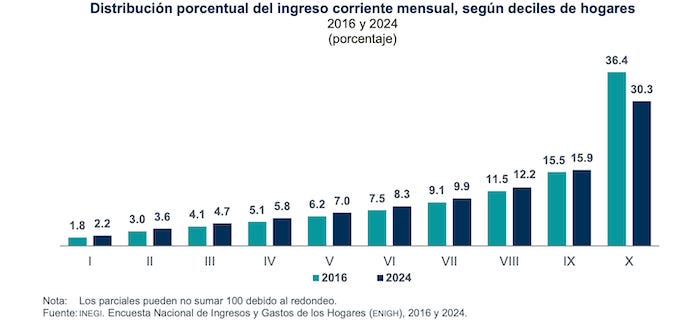The best of all possible worlds
A look at bullish and bearish news for the Mexican economy
Welcome to The Mexpatriate.
“Mexico has the lowest effective tariff rate in the world,” boasted Secretary of Economy Marcelo Ebrard on Wednesday at a press conference in Quintana Roo. Today, Trump’s new tariff rates with over 90 countries went into effect—but not in Mexico, as the two countries continue to negotiate under an extended deadline.
Ebrard claimed Mexico’s effective tariff rate is just 6.5%, but economic analysts have come up with varying calculations. Mexico’s comparatively strong position can be partly attributed to the Sheinbaum administration’s negotiating skills, but also to a reality that Trump hasn’t yet been able to resolve by firing someone, and indeed, helped to foster with the signature of the USMCA in his first term: Mexico retained its position as the United States’ largest trading partner in the first half of 2025 (followed by Canada and China), with a 6.3% annual increase in exports to the north.
And so, the Mexican government smiles nervously in the face of the new global trade disorder, while arduous negotiations with the U.S. loom ahead and a wobbly—if resilient—economic landscape takes shape at home.
In recent economic data:
The headline inflation rate in July dropped to its lowest level since December 2020 (3.51%) and the Bank of Mexico announced another 25 basis-point reduction in the key rate to 7.75% at its board meeting today (the fifth cut this year).
GDP growth in Q2 was better than forecast, rising 1.2% annually and 0.7% compared to the previous quarter; forecasts for annual GDP growth have been adjusted slightly upwards, ranging from 0.2% (IMF) to 0.5% (Citibank).
July saw a record number of formal sector jobs added (1.26 million), buoyed by the new labor law requiring that gig workers receive IMSS benefits; this came after three consecutive months of formal sector job losses, which likely would have continued without the addition of digital platform workers.
Remittances plummeted by 16.2% year-over-year in June, the largest drop since 2012 and BBVA predicts a 5.8% decline for 2025. The appreciation of the peso against the US dollar also meant the purchasing power of remittances has declined this year.
In today’s letter, I cover another economic story: the data on household income and inequality released by INEGI last week.
If you’d like to support The Mexpatriate, please consider upgrading to a paid subscription.
Another feather in the 4T’s economic cap
In a basket of statistics, there will always be cherries to pick for all sides, but the 2024 survey on household income and spending (ENIGH) published last week made it tough for opponents of the 4T to find sour ones.
The two biggest and brightest takeaways are that inequality in Mexico is ebbing, and overall income is rising.
The top income decile went from concentrating 36.4% of wealth in 2016 to 30.3% in 2024; average monthly income for Mexican households rose 10.6% compared to 2022 (and 15.6% compared to 2018). While labor income increased in every decile, the lowest decile saw a 13.8% increase, while the top decile rose 6.9%. Income from “transfers” (welfare programs and remittances) rose slightly as a percentage of total income compared to 2022, but labor still makes up the bulk (65.6%) of average household income, demonstrating the impact of minimum wage increases.
Sheinbaum celebrated the data as “very good news for Mexico” and as a vindication of the “for the good of all, the poor first” economic policies under AMLO and continued in her administration. She highlighted that between 2016 and 2024, the ratio between the income of the richest households to the poorest dropped from 21 to 14 to one.
Estimates indicate that a historic 10 to 11 million Mexicans were lifted out of poverty during AMLO’s term, from 2018-2024 (INEGI will publish this data later in August). This would mean a reduction in the poverty rate of nearly 10 percentage points—in the decade from 2008 to 2018, there was only a 2.5-point reduction.
“The sexenio of Obrador marked a before and after in the fight against poverty, and that is by far the main reason for the current president’s electoral success,” wrote analyst Viri Ríos in El País.
On the other side of the ledger, ENIGH 2024 showed household expenditure rose 7.9% compared to 2022, and out of every 100 pesos, Mexicans spend an average of 38 pesos on food (though in the lowest income decile, this shoots up to 51% of expenditure).
Regional disparities are still significant—the average household income in Nuevo León (the highest-ranked state) is almost three times more than in Chiapas (the lowest-ranked). In fact, Chiapas was the only state that saw average income decline between 2022 and 2024. Access to healthcare services improved compared to 2022 (63.3% compared to 59.9%) but is still lagging behind the 82.6% who reported having access to public health in 2016.
Critics of Morena see its economic successes as precarious, haunted by the specters of feeble growth, labor informality and unsustainable government spending on social programs. And yet, in the midst of a turbulent global context, Mexico made unexpected strides in improving the quality of life of its least privileged citizens under AMLO—hopefully Sheinbaum succeeds in repeating the trick.
Going deeper: If you’d like to learn more about how Mexico quantifies itself, check out this piece about INEGI from The Mexico Political Economist.
Questions, criticism or tips? Email me: hola@themexpatriate.com. And if you enjoyed this newsletter, please share it.





